A Visual Guide to 700 MHz
Mar 27, 2008, 10:40 PM by Rich Brome @rbrome.bsky.social
Your complete guide to the 700 MHz spectrum just auctioned off by the FCC to Verizon, AT&T, and Qualcomm.
Intro
The U.S. government recently auctioned off a large, important band of radio spectrum aptly named the "700 MHz band". The name may be simple, but digging into the details of this band, things get complicated quickly, so we've created this handy guide to explain all the nitty-gritty details.
The auctions for the 700 MHz band were conducted by the FCC (Federal Communications Commission,) the arm of the government responsible for (among other things) regulating radio spectrum and the industries that use it.
Since the beginning of the decade, the FCC has been working hard to rid the airwaves of inefficient analog television broadcasts, and replace them with a variety of more efficient digital services. This includes digital television, of course, but digital television - even in high-definition - is efficient enough that the move to digital will free a significant amount of radio spectrum for things other than television, such as new cell phone service.
The 700 MHz band is some of that newly-freed spectrum. It spans 698 - 806 MHz, which used to be UHF TV channels 52 - 69.
What the FCC just auctioned off in "Auction 73" is only part of the 700 MHz band. Some parts of the 700 MHz band were already sold off in earlier auctions, but it all dovetails together. If we only talked about Auction 73, you'd only get half the story, so we'll be covering the whole 700 MHz band in this article.
The following pages explore the details of the new 700 MHz band in depth. We're going to skip some of the basics of radio frequency bands in this article, but that doesn't mean you should. If you haven't read the primer we created for the last major FCC auction (the AWS band,) or you think you could use a refresher, be sure to go through the first three sections of our Visual Guide to AWS before going any further:
Now, for the rest of this article we'll assume you know all about bands, blocks, CMAs, and Hertz. Ready?
Band Plan
Here is how the 700 MHz band fits with the existing major bands in the US:
Major US Bands

The "700 MHz band" is actually two bands: Upper 700 MHz and Lower 700 MHz. Each has its own set of blocks. That means you need to be careful when talking about the 700 MHz "C Block", for example, because there are two different "C Blocks": one in Upper 700, and one in Lower 700.
To make it even more confusing, the FCC auction that just concluded - Auction 73 - included a mix of blocks from both Upper 700 and Lower 700 MHz bands.
700 MHz Blocks
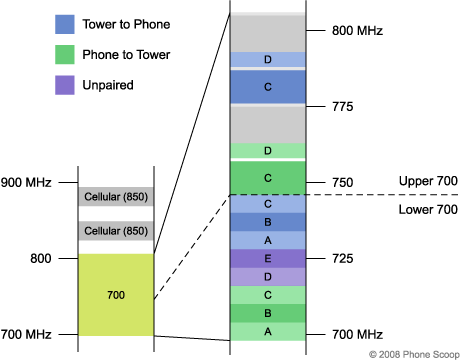
Prior to the recent Auction 73, there were Auctions 44 and 49. These saw the Lower 700 MHz blocks C and D auctioned off. Auction 44 was a first attempt, but didn't go very well, requiring Auction 49 to finish the process.
By the time Auction 49 was over, a variety of small no-name companies had grabbed various Lower C block licenses, and Qualcomm had grabbed the Lower D block nationwide.
Qualcomm currently uses the Lower D block for its MediaFLO mobile TV service for Verizon, and soon AT&T.
The Lower 700 D and E blocks are unpaired - shown above in purple. Unpaired means it is one continuous block of spectrum, ideal for one-way broadcasting (as Qualcomm does with MediaFLO.)
The alternative to unpaired is paired, meaning there are two separate bands: one for towers to transmit to phones, and one for phones to transmit back to towers. Most popular mobile phone technologies are designed to work with paired spectrum. As you can see above, the Lower 700 A, B, and C blocks are paired, as are the Upper 700 C and D blocks.
The Upper 700 MHz band also includes some very narrow paired bands, shown above in light gray. These are the Upper 700 A and B blocks. They're so small, though (1 MHz in each direction,) that they're not useful for mobile phone service. In slightly darker gray are blocks reserved for public safety radio systems.
Auction 73 included the Lower 700 blocks A, B, and E, plus Upper 700 blocks C and D.
700 MHz Blocks by Auction
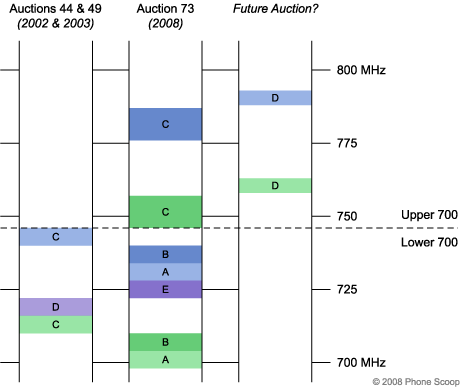
Aside from the paired versus unpaired issue, the Lower 700 MHz blocks are all standard fare. The Upper 700 blocks, though, come with strings attached.
The Upper C block has "open access" rules that require the license holder to allow third-party devices and applications to use the network built using that spectrum. This was quite a controversial issue when the rules were being drafted for this band, but in late 2007 - right before Auction 73 - the whole industry magically embraced open access, and has even started to compete on just how "open" they can be. Of course this didn't happen until the FCC was about to force it on them.
The Upper D block had special rules attached that would require the spectrum to be shared with public safety. A number of things went wrong with this plan, and there are even accusations of fraud, although that's beyond the scope of this article. What's important for now is that the reserve price was not met, so the Upper D block was not sold in Auction 73. The FCC is in the process of reviewing various options and will probably re-auction that block at a later date.
Verizon
Verizon really whipped out its wallet in Auction 73. It spent a whopping $9.4 billion in this auction.
Verizon won the most prized spectrum in the auction: the Upper 700 MHz C block. This particular slice of spectrum is valuable for two reasons: geography and bandwidth.
First, the FCC offered the Upper C block in just a handful of very large regions: six licenses cover the entire continental US. Verizon snagged all six, plus Hawaii.
Second, the Upper C block is a full 22 MHz wide, compared to 12 MHz for the other major blocks. That extra bandwidth means extra capacity, for handling more voice calls and/or more data.
(The Upper C block is the only Upper 700 MHz block successfully auctioned off to date, since the Upper D block failed to sell in Auction 73. Therefore any other blocks discussed in this article are in the Lower 700 MHz band.)
Verizon didn't stop there, though. It also picked up scattered extra licenses in the Lower A and B blocks in Auction 73. In some areas, it picked up both, giving it a grand total of 46 MHz of fresh 700 MHz spectrum in those areas, which include LA, Chicago, and Miami.
Verizon Wireless 700 MHz Licenses
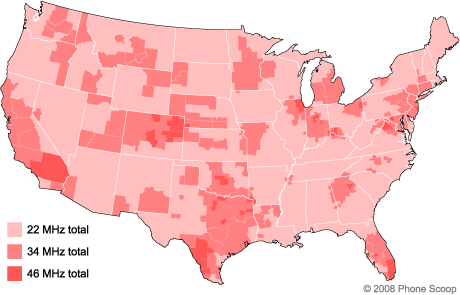
Each of these blocks is set up slightly differently. Besides the bandwidth difference mentioned above, the Lower A and B blocks are divided into different, smaller geographic areas. The Lower A block is divided up by EAs, while the Lower B block is divvied up by the much smaller CMAs. For example, Verizon's new A-block license for the LA area stretches all the way into Arizona, while their new B-block license for LA just covers LA and Anaheim.
Having 700 MHz spectrum completely nationwide gives Verizon the unique opportunity to launch a whole new national network with relative ease, which is extremely rare. Although they haven't announced specific plans, it would be perfect spectrum for Verizon to launch its new LTE network.
AT&T
AT&T Mobility just bought some fresh 700 MHz spectrum in the Lower B block, but it owned quite a bit of 700 MHz spectrum even before Auction 73, thanks to the recent purchase of Aloha Partners, which in turn had previously acquired Cavalier Group and DataCom Wireless. Aloha, Cavalier, and DataCom were the three biggest players in Auctions 44 and 49, where they bought most of the important licenses in the Lower 700 MHz C block. (Not to be confused with the Upper 700 C block just purchased by Verizon.)
AT&T also went after a number of smaller existing 700 MHz license holders with names like Harbor Wireless, McElroy Electronics, and even some guy named Scott Reiter. AT&T's purchase of Aloha - together with its spoils from Auction 73 - gave it coverage of most major markets. It took deals with the smaller companies, though, to secure the few remaining key markets like Miami, Des Moines, and Raleigh-Durham.
Now that AT&T has swallowed up all of these companies (or at least their 700 MHz licenses,) and done its thing in Auction 73, its combined B & C block holdings in the Lower 700 MHz band look like this:
AT&T 700 MHz Licenses
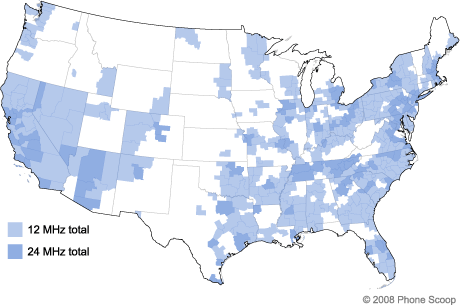
There are a number of places where AT&T now has both the B and C block licenses in the Lower 700 MHz band. This gives it double the bandwidth - 24 MHz total - in those areas. Such areas include Baltimore, Boston, Cleveland, Dallas, Detroit, Houston, New York, Philadelphia, St. Louis, San Francisco, and Washington.
Chicago, LA, and Miami are key cities missing from that list, because Verizon Wireless out-bid AT&T in those cities. AT&T still has the 12 MHz C block in those cities, but whatever AT&T has planned for its 700 MHz spectrum, it won't have as much capacity for it in those cities.
Both the Lower B and Lower C blocks are divided up by CMAs. By avoiding the Lower A block - which is divided by EAs instead - AT&T kept its 700 MHz holdings a bit simpler by sticking to one system of geographic divisions. That way all of its licenses fit together like a jigsaw puzzle, with no unnecessary overlap.
AT&T hasn't announced what it will do with its 700 MHz spectrum, although LTE and WiMAX seem like the two most likely options.
What is known is that it spent at least $9 billion between Auction 73 and buying Aloha, so it's doubtful it'll let such valuable purchases sit idle for too long.
Qualcomm, etc.
Qualcomm has already been using the Lower 700 MHz D block for its MediaFLO service that broadcasts live TV directly to phones. In Auction 73, Qualcomm picked up just a few of the similar (unpaired) E block licenses. It picked top markets, though: Boston, LA, New York, Philadelphia, and San Francisco.
Qualcomm 700 MHz Licenses
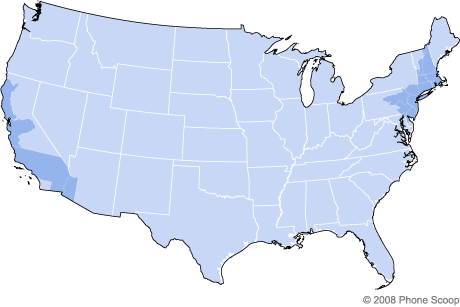
Since the E block is also unpaired, and so close to the D block, it would make sense for Qualcomm to use it for MediaFLO as well, or a related service. One guess is that Qualcomm will use it to offer local TV channels in those five key markets.
Even though it only bought five licenses in the E block, it cost Qualcomm over $550 million.
One familiar - but odd - name in Auction 73 was MetroPCS. It bought a large A-block license covering Boston... and that one license is all it bought, which is what's odd. It didn't participate in auctions 44 or 49, either. To have one lone city that uses a completely different frequency band from the rest of your network is generally not a good idea. MetroPCS felt sure enough about it to spend over $310 million on that license, though, so we assume it has some kind of plan.
Cox, Vulcan, Frontier, and King Street* were other companies laying out large sums for various licenses in Auction 73.
(Update: King Street is associated with US Cellular.)
Cox is a major cable TV company. It purchased a mix of Lower A and B block licenses. That's paired spectrum, so it's possible it could launch some kind of phone service with it. Major cities covered by those licenses include Las Vegas, Phoenix, and San Diego.
Frontier is a part of EchoStar, known for its Dish Network satellite TV service. Frontier is a curious entry, partly because it bought unpaired Lower 700 E-block licenses. Since the largest cities in the Lower E block were snapped up by Qualcomm, that leaves Frontier with the relative scraps. Whatever it does, it probably won't be anything like mobile phone service, though, since the band is unpaired.
None of these smaller bidders came away with anything approaching a national reach.
Comments
US Cellular
We're busy with CTIA right now, but right after the show, we'll dig into that and have a map and breakdown for you guys.
P...
(continues)
So what does this mean for ATT?
Still, it is hard to imagine them launching a really major technology that excludes most rural regions and even whole states.
I would guess that they w...
(continues)
Existing Spectrum?
Does 700 MHz improve reception?
However, 700 MHz is not much different than 850 MHz. In fact, 850 (cellular) almost starts where 700 ends. Therefore you won't see much difference compared to cellular networks.
You might see a difference compared to an al...
(continues)
When are they required to launch it?
I looked through the FCC rules and the ten-year-rule seemed to be the applicable one...right from the rules for this auction. I'll have to look into it closer after C...
(continues)
Does Verizon's total 700 MHz holdings equal more than AT&T's?
I was unsure whether that map you made with AT&T's holdings represented EVERYTHING, including the Aloha purchase, or just what it won in auction 73?
I had been under the impression that it's B block purchases in combination with the Aloha purchase and other snap ups actually came to a larger (and complete) national coverage then Verizon. Is that not true?
Excellent article.
It is much less than Verizon's in both geography and bandwidth. (Even though they may have paid slightly more when you add up auctions and all of the private purchases.)
Question about the maps
Is there any such diagram detailing the carriers current licenses for other bands like Cellular and PCS?
Digg It!!!
Digg this story and spread the joy of phonescoop!


 iPhone 16 Brings More Features to All Price Points, Including New Camera Control
iPhone 16 Brings More Features to All Price Points, Including New Camera Control
 Qualcomm's New Chip for Entry-Level Phones Moves to 4nm
Qualcomm's New Chip for Entry-Level Phones Moves to 4nm
 iOS 18 Overhauls Home Screen, Messaging, Photos
iOS 18 Overhauls Home Screen, Messaging, Photos
 Apple iOS 26 Brings a New Look and Long List of New Features
Apple iOS 26 Brings a New Look and Long List of New Features






